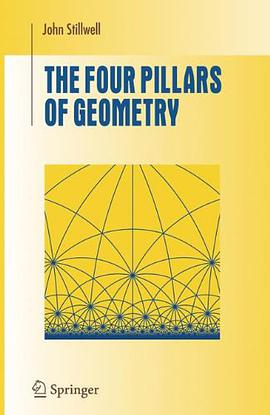The Four Pillars of Geometry
内容简介
For two millennia the right way to teach geometry was the Euclidean approach, and in many respects, this is still the case. But in the 1950s the cry "Down with triangles!" was heard in France and new geometry books appeared, packed with linear algebra but with no diagrams. Was this the new right approach? Or was the right approach still something else, perhaps transformation groups?
The Four Pillars of Geometry approaches geometry in four different ways, spending two chapters on each. This makes the subject accessible to readers of all mathematical tastes, from the visual to the algebraic. Not only does each approach offer a different view; the combination of viewpoints yields insights not available in most books at this level. For example, it is shown how algebra emerges from projective geometry, and how the hyperbolic plane emerges from the real projective line.
The author begins with Euclid-style construction and axiomatics, then proceeds to linear algebra when it becomes convenient to replace tortuous arguments with simple calculations. Next, he uses projective geometry to explain why objects look the way they do, as well as to explain why geometry is entangled with algebra. And lastly, the author introduces transformation groups---not only to clarify the differences between geometries, but also to exhibit geometries that are unexpectedly the same.
All readers are sure to find something new in this attractive text, which is abundantly supplemented with figures and exercises. This book will be useful for an undergraduate geometry course, a capstone course, or a course aimed at future high school teachers.
......(更多)
作者简介
John Stillwell is Professor of Mathematics at the University of San Francisco. He is the author of several highly regarded books published by Springer, including Elements of Number Theory (2003), Mathematics and Its History (Second Edition, 2002), Numbers and Geometry (1998) and Elements of Algebra (1994).
......(更多)
目录
Preface --
1. Straightedge and compass --
1.1. Euclid's construction axioms --
1.2. Euclid's construction of the equilateral triangle --
1.3. Some basic constructions --
1.4. Multiplication and division--
1.5. Similar triangles --
1.6. Discussion --
2. Euclid's approach to geometry --
2.1. The parallel axiom --
2.2. Congruence axioms --
2.3. Area and equality --
2.4. Area of parallelograms and triangles --
2.5. The Pythagorean theorem --
2.6. Proof of the Thales theorem --
2.7. Angles in a circle --
2.8. The Pythagorean theorem revisited --
2.9. Discussion --
3. Coordinates --
3.1. The number line and the number plane --
3.2. Lines and their equations --
3.3. Distance --
3.4. Intersections of lines and circles --
3.5. Angle and slope --
3.6. Isometries --
3.7. The three reflections theorem --
3.8. Discussion --
4. Vectors and euclidean spaces --
4.1. Vectors --
4.2. Direction and linear independence --
4.3. Midpoints and centroids --
4.4. The inner product --
4.5. Inner product and cosine --
4.6. The triangle inequality --
4.7. Rotations, matrices, and complex numbers --
4.8. Discussion.
5. Perspective --
5.1. Perspective drawing --
5.2. Drawing with straightedge alone --
5.3. Projective plane axioms and their models --
5.4. Homogeneous coordinates --
5.5. Projection --
5.6. Linear fractional functions --
5.7. The cross-ratio --
5.8. What is special about the cross-ratio? --
5.9. Discussion --
6. Projective planes --
6.1. Pappus and Desargues revisited --
6.2. Coincidences --
6.3. Variations on the Desargues theorem --
6.4. Projective arithmetic --
6.5. The field axioms --
6.6. The associative laws --
6.7. The distributive law --
6.8. Discussion --
7. Transformations --
7.1. The group of isometries of the plane --
7.2. Vector transformations --
7.3. Transformations of the projective line --
7.4. Spherical geometry --
7.5. The rotation group of the sphere --
7.6. Representing space rotations by quaternions --
7.7. A finite group of space rotations --
7.8. The group S³ and RP³ --
7.9. Discussion --
8. Non-Euclidean geometry --
8.1. Extending the projective line to a plane --
8.2. Complex conjugation --
8.3. Reflections and Mobius transformations --
8.4. Preserving non-Euclidean lines --
8.5. Preserving angle --
8.6. Non-Euclidean distance --
8.7. Non-Euclidean translations and rotations --
8.8. Three reflections or two involutions --
8.9. Discussion --
References --
Index.
......(更多)
读书文摘
......(更多)






